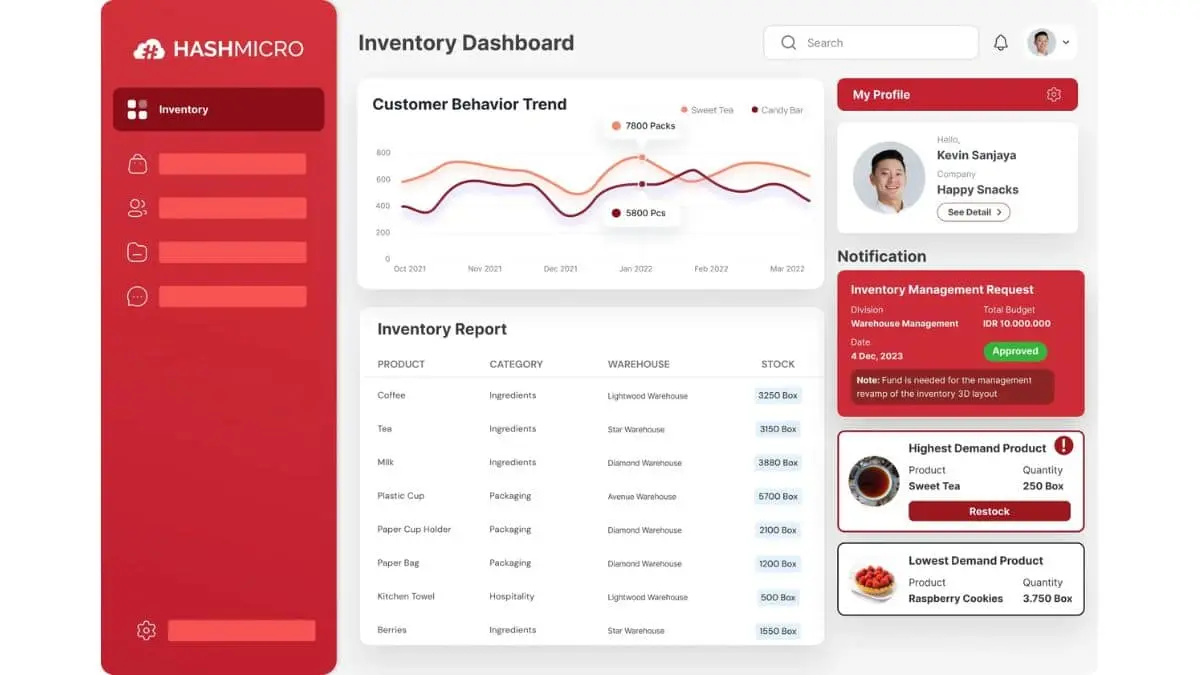In today’s fast-paced global market, businesses face significant challenges in meeting customer demands while keeping operations efficient. Any delay or misstep in the supply chain—whether at a manufacturer’s end, a storage facility, or within logistics—can cause costly disruptions.
Surprisingly, inventory management, often seen as routine, plays a pivotal role in preventing these issues. Poor control can lead to overstocking, which ties up resources and increases waste, or understocking, which halts production and disappoints customers.
Effective inventory tracking is the key to helping companies balance supply and demand while keeping costs low. But finding the right balance isn’t always easy, which is why using smart, data-driven inventory management is so important.
Table of Contents

Key Takeaways
|
What is Inventory Tracking?
Given the huge problems caused by poor inventory management, it’s clear that understanding inventory tracking is the first step to getting better results. Inventory tracking isn’t just about counting items; it’s about knowing exactly what you have at every stage of its life.
Inventory tracking means keeping records of a product at every stage, whether it’s raw materials or finished goods inventory. By tracking items in real time, businesses can keep the right amount of stock and avoid problems in their supply chain.
Imagine you run a small online store that sells handmade candles. With good inventory tracking, you know exactly how many candles you have at every stage—from raw materials like wax and wicks to the finished candles ready for sale.
If your tracking shows that you’re low on wicks, you can order more before running out, ensuring you can keep making candles without delays. This helps you maintain a smooth operation and meet customer demand on time.
Key Components of Inventory Tracking
Inventory tracking isn’t just about knowing what’s in your warehouse—it encompasses monitoring stock levels, keeping accurate records, and ensuring smooth operations. Here are the primary components:
- Stock Levels and Quantity: Track how many units of each item you have on hand.
- Stock Locations: Monitor where items are stored across multiple locations.
- Inventory Accuracy: Ensure the recorded inventory levels match the actual inventory counts.
- Carrying Costs: Calculate the expenses involved in storing unsold goods.
- Turnover Ratios: Measure how quickly products are sold or used.
Understanding these components and implementing another inventory software set the foundation for what should be tracked in inventory management, which is the next critical aspect of this discussion.
What is Tracked in Inventory Management?
Now that we have a grasp on the key components, let’s dive deeper into what businesses need to track to maintain effective inventory management. Accurate tracking requires monitoring more than just quantities; it’s about a detailed overview of stock movement, locations, and associated costs.
Stock levels and quantity
The foundation of inventory tracking lies in knowing exactly how much stock you have at any given time. Misjudging stock levels can lead to costly errors—either running out of products or holding too much inventory.
Inventory locations
Tracking where your stock is located is crucial, especially for businesses with multiple warehouses or distribution centers. Accurate location data reduces the time spent searching for items and streamlines order fulfillment.
But keeping track of stock levels and locations is just the beginning. You also need to consider financial factors like valuation, turnover, and reorder points.
Inventory valuation and costs
Inventory valuation methods like FIFO (First-In, First-Out) or LIFO (Last-In, First-Out) impact your financial reporting. Tracking the value of your inventory ensures accurate financial statements and helps in setting profitable prices.
Inventory turnover rates
This metric tells you how often your inventory is sold and replaced over a period. High turnover rates indicate strong sales, while low turnover may signal slow-moving stock that ties up capital.
Reorder points and levels
Automated reorder points help you maintain optimal stock levels. Setting the right reorder levels minimizes the risk of running out of stock while avoiding overstocking.
While understanding what to track is essential, choosing the right tracking method is just as important. So, how do you decide between manual and automated inventory tracking?
Manual vs. Automated Inventory Tracking: Which is Better?
As your business grows, the choice between manual and automated tracking becomes more significant. Once a staple, manual tracking methods are now competing with modern automated solutions that offer speed and accuracy.
Manual tracking (Pen and Paper, Spreadsheets)
Manual methods are prone to human error, time-consuming, and inefficient for growing businesses. As inventory scales, it becomes increasingly difficult to manage data manually without introducing inaccuracies.
Automated solutions (Software and Mobile Apps)
Automated systems offer real-time updates, reduce errors, and improve overall efficiency. From barcode scanning to integrated mobile apps, automated inventory tracking allows businesses to scale operations seamlessly without worrying about data inaccuracies.
With the right tracking method in place, businesses can fully realize the benefits of effective inventory management.
Benefits of Effective Inventory Tracking
When done right, inventory tracking delivers numerous benefits that enhance operational efficiency and profitability. These benefits are why businesses of all sizes invest in advanced tracking systems.
Improved stock visibility
One major benefit of good inventory tracking is better stock visibility. When you know exactly what’s in stock at all times, you can make quick and smart decisions. This helps you avoid running out of popular items, which could lead to lost sales and unhappy customers. With real-time data, you can respond quickly to changes in demand.
Better visibility also means you can manage your resources more efficiently. You can reorder items at the right time, avoid overstocking, and reduce waste. This keeps your operations lean and your customers satisfied. Using SKU is one of the ways to easily increase your stock visibility.
Reduced stockouts and overstocks
Balancing your stock levels is crucial for smooth operations and healthy cash flow. Good inventory tracking helps you avoid stockouts, where you run out of items and miss sales, as well as overstocks, where you have too much inventory taking up space and money. By keeping your stock levels in check, you can ensure that your resources are used efficiently.
This balance helps improve your cash flow by reducing the money tied up in excess stock. It also ensures that you have enough inventory to meet customer demand, keeping your operations running smoothly.
Enhanced inventory forecasting
Accurate inventory tracking gives you the data you need for better forecasting. With reliable data, you can predict future demand more accurately, helping you plan ahead. This means fewer surprises and last-minute rushes, making your supply chain activities more efficient.
Better forecasting also leads to stronger relationships with suppliers and customers. You can avoid delays and ensure that products are available when needed, leading to happier customers and smoother operations.
Better error detection and correction
Automated inventory tracking systems help catch and fix errors quickly. Manual tracking can lead to mistakes, but automated systems can spot inconsistencies in real-time. This helps you correct issues before they become bigger problems, improving overall accuracy.
By reducing errors, you also get more accurate financial reports and inventory records. This makes it easier to make informed business decisions and stay compliant with regulations. Over time, this leads to more efficient and reliable operations.
Challenges in Inventory Tracking
While the benefits are clear, inventory tracking comes with certain hurdles that businesses need to overcome. Recognizing these challenges is the first step toward mitigating them.
Time-Consuming Processes
Manually tracking inventory takes a lot of time, especially as your inventory grows. This process can take away valuable time that could be spent on other important tasks. Without automation, inventory management can quickly become overwhelming.
The more time you spend on manual tracking, the more likely you are to make mistakes. This can lead to delays, discrepancies, and lost sales. To avoid these issues, many businesses turn to automated systems that save time and reduce errors.
Difficulty in Managing Larger Inventories
As your business grows, managing a larger inventory becomes more difficult. Larger inventories often have many different products, making it harder to keep track of everything. Without a reliable system, managing this complexity can lead to errors and inefficiencies. Using the ABC inventory technique might be one of the ways to deal with this problem.
Advanced tools can help manage large inventories by providing real-time visibility and automating tasks. By investing in the right system, businesses can keep their operations efficient and profitable, even as they grow.
Inaccuracies and human error
Human error is a common challenge in inventory tracking. Simple mistakes, like entering the wrong data or miscounting items, can lead to big problems. These errors can cause stock discrepancies, leading to lost sales and unhappy customers.
To reduce the risk of human error, many businesses use automated tracking systems. These systems minimize the need for manual data entry, reducing the chance of mistakes. This leads to more accurate inventory records and better overall management.
You also need to remember that submitting your inventory list to the Bureau of Internal Revenue (BIR) is mandatory. Double-check that all receipts and invoices meet the inventory list BIR requirements.
Inventory Tracking Methods: Finding the Right Fit
Choosing the right inventory tracking method is key to running your business smoothly. Whether you have a small business or a large enterprise, different methods offer different benefits. It’s important to pick a method that fits your current needs and can grow with your business.
The right method can help you manage your inventory more efficiently. So, take the time to understand the pros and cons of each method so you can choose the best one for your business.
Barcode systems
Barcode systems are popular because they’re simple and affordable. Each product gets a unique barcode that you can scan to track its movement. This method is great for businesses with a lot of items, as it saves time and reduces manual counting errors. A barcode inventory system can further enhance this process, ensuring even greater accuracy and efficiency in managing stock.
Setting up a barcode system is easy—you just need a barcode printer and scanner. It’s effective in keeping your inventory records accurate and speeding up the checkout process. However, barcodes need to be scanned directly, which might be a limitation in some setups. Overall, barcode systems are a reliable and cost-effective option.
RFID tracking
RFID (Radio Frequency Identification) is a more advanced tracking method. Unlike barcodes, RFID tags don’t need to be scanned directly, so you can track items faster and more flexibly. This makes RFID ideal for large-scale operations where speed is crucial.
RFID provides real-time tracking, giving you up-to-the-minute information on your inventory. This can help you make better decisions, especially in fast-paced industries. While RFID is more expensive to set up, the increased efficiency and accuracy can make it worth the investment for large or complex operations.
Inventory management software
Cloud inventory management software offers a modern approach to tracking. It integrates inventory with other business processes like sales and procurement, giving you a complete view of your operations. This software helps automate tasks, reduce errors, and make better decisions with real-time data.
One major benefit is the end-to-end visibility it provides across the supply chain. You can track inventory from the moment it’s ordered until it’s sold. This visibility helps you manage stock levels proactively and identify slow-moving items. While it can be more expensive and complex to implement, the long-term benefits make it a smart choice for many businesses.
No matter which method you choose, following best practices is important to get the most out of your system. Regularly train your staff on how to use the system properly. Keep your inventory organized and up-to-date to avoid discrepancies.
Best Practices for Efficient Inventory Tracking
Efficient inventory tracking isn’t just about having the right tools; it’s about combining those tools with proven strategies.
- Regular Cycle Counts and Audits: Regular cycle counts help ensure your recorded inventory matches what’s on hand, maintaining accuracy.
- Monitoring Inventory Movement and Lifecycle: Understanding your inventory’s lifecycle—from procurement to sales—enables better resource allocation and forecasting.
- Implementing Digital Tracking and Automation: Automating inventory tracking minimizes errors and boosts efficiency by providing real-time updates.
- Customizing Reports and Dashboards: Tailored reports and dashboards help you track the KPIs that matter most to your business, from stock levels to reorder points.
To truly optimize inventory tracking, integrating it with a comprehensive management system like HashMicro’s Inventory management system can offer even more significant benefits.
How HashMicro’s Software Can Level Up Your Inventory Tracking
Enhancing your inventory tracking with HashMicro’s advanced software can revolutionize the way your business manages stock. HashMicro’s Inventory Software offers several advantages that align perfectly with the key aspects of inventory tracking:
- Real-Time Stock Monitoring: Keep an eye on your stock levels with instant updates, reducing stockouts and excess inventory.
- Multi-Location Management: Seamlessly manage inventory across multiple warehouses or locations.
- Automated Reorder Points: Set reorder levels that trigger automated purchase orders, ensuring optimal stock at all times.
- Detailed Reporting: Get custom reports and insights to support data-driven decisions.
- Scalability and Flexibility: Scale your inventory management operations as your business grows, without missing a beat.
Integrating such software ensures you remain competitive while effectively handling inventory challenges. If you’re ready to take your inventory management to the next level, explore our recommendations for best inventory management software to find the perfect solution for your business needs.
Conclusion
Efficient inventory tracking is a critical element for business success. Whether you’re running a small store or managing a large-scale operation, having the right tools and practices in place can prevent stockouts, overstocking, and operational inefficiencies that hurt profitability.
Manual methods and outdated systems often lead to inaccuracies, but adopting advanced solutions like HashMicro Inventory Software helps businesses streamline their processes and make data-driven decisions with ease.
With HashMicro’s Inventory Software, you gain real-time stock visibility, optimize reorder points, and improve overall supply chain management. The platform is designed to scale with your business, offering flexibility and automation that simplify complex inventory tasks.
Ready to transform your inventory management? Try HashMicro Inventory Software today and see the difference it can make in your business with a free demo tailored to your specific needs.

FAQ About Inventory Tracking
-
How to better track inventory?
To better track inventory, use a modern inventory management system for real-time updates. Employ barcode or RFID technology to streamline recording. Conduct regular audits to reconcile discrepancies, optimize reorder points based on data, and train your team in best practices.
-
What is daily inventory tracking?
Daily inventory tracking involves updating and monitoring inventory levels on a daily basis. This method provides real-time visibility into stock levels, helping businesses quickly identify and address issues such as stockouts or overstock. It often uses automated systems to streamline the process and maintain accuracy.
-
What is the purpose of inventory tracking?
The purpose of inventory tracking is to monitor and manage stock levels, ensuring that businesses have the right amount of inventory on hand. It helps prevent stockouts, reduce excess inventory, optimize order processes, and maintain accurate financial records. Effective tracking improves supply chain efficiency and supports overall business operations.
{
“@context”: “https://schema.org”,
“@type”: “FAQPage”,
“mainEntity”: [{
“@type”: “Question”,
“name”: “How to better track inventory?”,
“acceptedAnswer”: {
“@type”: “Answer”,
“text”: “To better track inventory, use a modern inventory management system for real-time updates. Employ barcode or RFID technology to streamline recording. Conduct regular audits to reconcile discrepancies, optimize reorder points based on data, and train your team in best practices.”
}
},{
“@type”: “Question”,
“name”: “What is daily inventory tracking?”,
“acceptedAnswer”: {
“@type”: “Answer”,
“text”: “Daily inventory tracking involves updating and monitoring inventory levels on a daily basis. This method provides real-time visibility into stock levels, helping businesses quickly identify and address issues such as stockouts or overstock. It often uses automated systems to streamline the process and maintain accuracy.”
}
},{
“@type”: “Question”,
“name”: “What is the purpose of inventory tracking?”,
“acceptedAnswer”: {
“@type”: “Answer”,
“text”: “The purpose of inventory tracking is to monitor and manage stock levels, ensuring that businesses have the right amount of inventory on hand. It helps prevent stockouts, reduce excess inventory, optimize order processes, and maintain accurate financial records. Effective tracking improves supply chain efficiency and supports overall business operations.”
}
}]
}










































